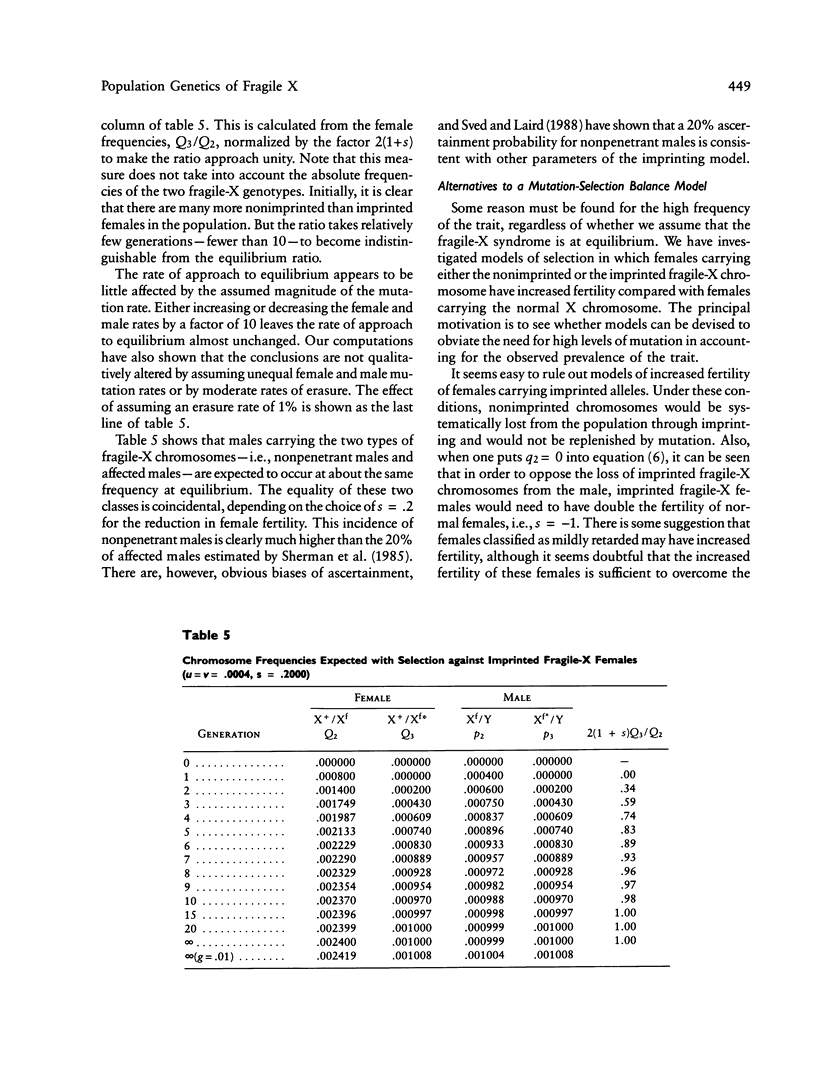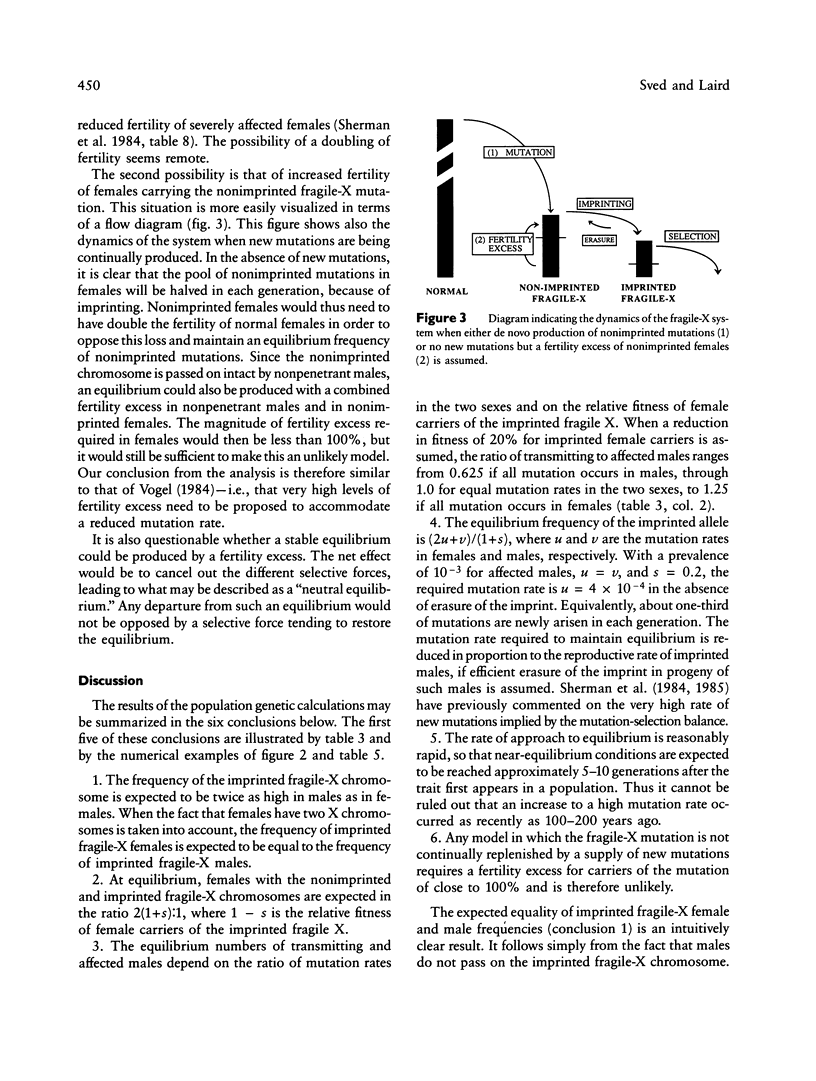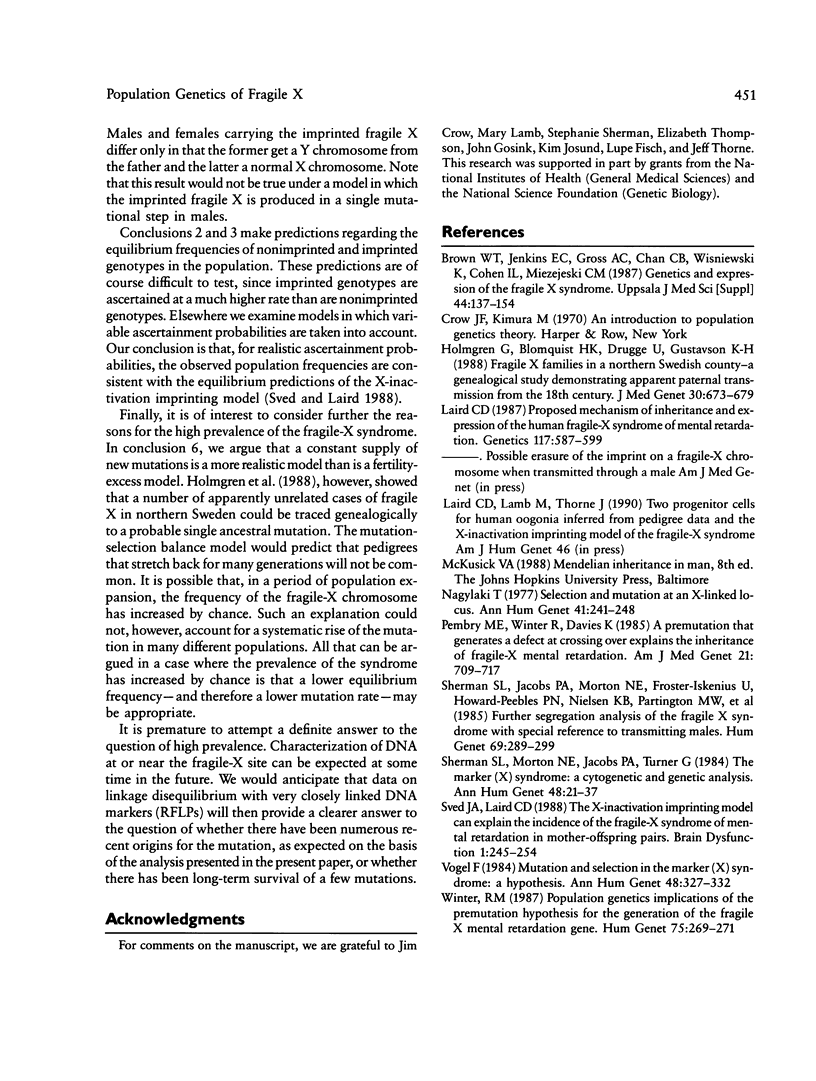Abstract
We have examined the population genetic consequences of the model of Laird (Genetics 117:587-599, 1987) in which the fragile-X syndrome is caused by "imprinting" of a mutant chromosome. The imprinting event in this model results from a block to reactivation of an inactive X chromosome prior to oogenesis. If it is assumed that males carrying the imprinted chromosome never reproduce, the frequencies of females and males carrying the imprinted chromosome are expected to be equal. When a mutation-selection balance is established, there are expected to be somewhat more than twice as many females carrying the nonimprinted fragile X as carry the imprinted fragile-X chromosome, the excess depending on the fertility of fragile-X females. Nonpenetrant (transmitting) males, i.e., those with the nonimprinted fragile-X chromosome, are expected to be present at about the same frequency as are males with the syndrome. More than one-third of the nonimprinted chromosomes in the population are expected to be newly arisen in each generation. We have considered possible alternatives to the model of a mutation-selection balance. Nonimprinted carrier females would need to have 100% fertility excess to avoid postulating a high mutation rate to account for the very high prevalence of the syndrome.
Full text
PDF








Selected References
These references are in PubMed. This may not be the complete list of references from this article.
- Brown W. T., Jenkins E. C., Gross A. C., Chan C. B., Wisniewski K., Cohen I. L., Miezejeski C. M. Genetics and expression of the fragile X syndrome. Ups J Med Sci Suppl. 1987;44:137–154. [PubMed] [Google Scholar]
- Holmgren G., Blomquist H. K., Drugge U., Gustavson K. H. Fragile X families in a northern Swedish county--a genealogical study demonstrating apparent paternal transmission from the 18th century. Am J Med Genet. 1988 May-Jun;30(1-2):673–679. doi: 10.1002/ajmg.1320300168. [DOI] [PubMed] [Google Scholar]
- Laird C. D. Proposed mechanism of inheritance and expression of the human fragile-X syndrome of mental retardation. Genetics. 1987 Nov;117(3):587–599. doi: 10.1093/genetics/117.3.587. [DOI] [PMC free article] [PubMed] [Google Scholar]
- Nagylaki T. Selection and mutation at an X-linked locus. Ann Hum Genet. 1977 Oct;41(2):241–248. doi: 10.1111/j.1469-1809.1977.tb01920.x. [DOI] [PubMed] [Google Scholar]
- Pembrey M. E., Winter R. M., Davies K. E. A premutation that generates a defect at crossing over explains the inheritance of fragile X mental retardation. Am J Med Genet. 1985 Aug;21(4):709–717. doi: 10.1002/ajmg.1320210413. [DOI] [PubMed] [Google Scholar]
- Sherman S. L., Jacobs P. A., Morton N. E., Froster-Iskenius U., Howard-Peebles P. N., Nielsen K. B., Partington M. W., Sutherland G. R., Turner G., Watson M. Further segregation analysis of the fragile X syndrome with special reference to transmitting males. Hum Genet. 1985;69(4):289–299. doi: 10.1007/BF00291644. [DOI] [PubMed] [Google Scholar]
- Sherman S. L., Morton N. E., Jacobs P. A., Turner G. The marker (X) syndrome: a cytogenetic and genetic analysis. Ann Hum Genet. 1984 Jan;48(Pt 1):21–37. doi: 10.1111/j.1469-1809.1984.tb00830.x. [DOI] [PubMed] [Google Scholar]
- Vogel F. Mutation and selection in the marker (X) syndrome. A hypothesis. Ann Hum Genet. 1984 Oct;48(Pt 4):327–332. doi: 10.1111/j.1469-1809.1984.tb00846.x. [DOI] [PubMed] [Google Scholar]
- Winter R. M. Population genetics implications of the premutation hypothesis for the generation of the fragile X mental retardation gene. Hum Genet. 1987 Mar;75(3):269–271. doi: 10.1007/BF00281072. [DOI] [PubMed] [Google Scholar]


